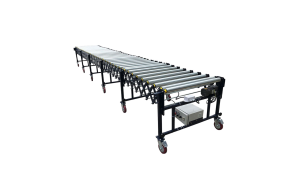A flexible power roller conveyor combines the versatility of a flexible design with the efficiency of powered rollers. This type of conveyor is ideal for dynamic and fast-paced environments where the conveyor layout needs to be frequently adjusted. Here’s an in-depth look at the components, design, applications, benefits, and maintenance of flexible power roller conveyors:

Components
- Power Rollers
- Material: Typically made from steel, aluminum, or high-impact plastic.
- Design: Powered rollers equipped with internal motors or driven by external motors.
- Spacing: Adjustable spacing to accommodate different sizes and types of products.
- Frame
- Material: Constructed from durable metals like steel or aluminum.
- Design: Flexible and expandable, with sections that can bend and twist to fit various layouts and spaces.
- Construction: Modular, allowing for easy expansion by connecting additional sections.
- Leg Supports
- Adjustability: Adjustable in height to ensure the conveyor is level and can match the height of other equipment or surfaces.
- Mobility: Equipped with casters or wheels, making it easy to move the conveyor to different locations.
- Stability: Legs can be locked in place to provide a stable base, preventing the conveyor from moving during use.
- Drive System
- Motor: Powers the rollers, providing consistent movement.
- Drive Belts/Chains: Transmits power from the motor to the rollers.
- Control System: Manages the speed, direction, and operation of the rollers.
- Connecting Hooks
- Function: Used to link multiple conveyor sections together, creating a continuous path for materials.
- Design: Simple hooks or latch mechanisms that are easy to connect and disconnect.
- Strength: Must be robust enough to maintain alignment and stability when sections are joined.
- Brakes
- Location: Typically installed on the rollers or the frame to control the movement of the conveyor.
- Function: Prevents the conveyor from moving or rolling items unintentionally, especially important on inclines.
- Types: Manual brakes that are engaged by hand or foot, and automatic brakes that activate when the conveyor is not in use.
- Side Rails
- Material: Same as the frame, usually steel or aluminum.
- Function: Prevents items from falling off the sides of the conveyor.
- Adjustability: Can often be adjusted or removed based on the size of the items being conveyed.
- Sensors and Controls
- Sensors: Detect the presence of items and control the conveyor’s operation.
- Controls: PLC (Programmable Logic Controller) systems to automate conveyor functions and integrate with other systems.
Applications
- Warehousing and Distribution: For loading and unloading trucks, trailers, and containers.
- Assembly Lines: To move parts and products between different stages of production.
- Packaging: For transporting packaged goods to shipping areas.
- Retail: For stocking shelves and moving products in back rooms.
- E-commerce: For sorting and moving packages in fulfillment centers.
Benefits
- Flexibility: The ability to expand, contract, and curve the conveyor makes it adaptable to various spaces and layouts.
- Portability: Equipped with casters, these conveyors can be easily moved and repositioned as needed.
- Efficiency: Powered rollers provide consistent movement, improving throughput and productivity.
- Ease of Use: Simple design makes it easy to set up, use, and maintain.
- Space-Saving: Can be contracted and stored when not in use, saving valuable floor space.
- Safety: Controlled movement reduces the risk of product damage and improves handling safety.
Design Considerations
- Load Capacity: Ensure the conveyor is designed to handle the maximum load of the products being conveyed.
- Speed: Determine the appropriate conveyor speed for efficient product handling without causing damage.
- Layout: Design the conveyor layout to fit the available space and workflow requirements.
- Product Specifications: Consider the size, shape, and weight of the products being conveyed.
- Environmental Conditions: Consider factors such as temperature, humidity, and exposure to chemicals when selecting materials.
- Safety Features: Incorporate guards, sensors, and emergency stop mechanisms to ensure safe operation.


